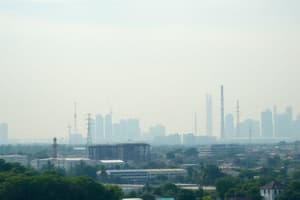Podcast
Questions and Answers
What is a potential impact of UV-B and UV-C exposure on human health?
What is a potential impact of UV-B and UV-C exposure on human health?
What is an impact of climate change on forestry?
What is an impact of climate change on forestry?
What is an impact of climate change on agriculture?
What is an impact of climate change on agriculture?
What is an impact of climate change on fishery?
What is an impact of climate change on fishery?
Signup and view all the answers
What is an impact of climate change on coastal zones?
What is an impact of climate change on coastal zones?
Signup and view all the answers
What is an impact of UV-B and UV-C exposure on the environment?
What is an impact of UV-B and UV-C exposure on the environment?
Signup and view all the answers
What is an impact of climate change on extreme weather events?
What is an impact of climate change on extreme weather events?
Signup and view all the answers
What is an impact of climate change on human health?
What is an impact of climate change on human health?
Signup and view all the answers
What is a impact of climate change on building structures?
What is a impact of climate change on building structures?
Signup and view all the answers
What is an impact of UV-B and UV-C exposure on human health?
What is an impact of UV-B and UV-C exposure on human health?
Signup and view all the answers
Study Notes
Air Quality
- Pertains to the degree of air cleanliness, clarity, and freedom from pollutants like smoke, dust, and smog.
- Factors affecting air quality: particulate matter, critical air contaminants, smog, persistent organic pollutants, and ozone.
Improving Air Quality
- Individual actions: carpooling, wise consumer purchases.
- Community actions: "green" projects, bike paths.
- Provincial actions: closing down incinerators.
- National/International actions: Kyoto accord.
Methods to Improve Air Quality
- Cleaner burning fuels.
- End of pipe technology.
- Catalytic converters.
Health Issues with Poor Air Quality
- Dust mites.
- Pet dander.
- Mold in older or poorly ventilated buildings.
- Pollens.
- Respiratory health: asthma.
The Grasshopper Effect
- The process of transporting certain chemicals (like POPs) from warmer to colder regions, especially the poles and mountain tops.
Bioaccumulation and Biomagnification
- Bioaccumulation: build-up of substances within an organism.
- Biomagnification: build-up of substances through the trophic levels of a food chain.
- Fat-soluble substances dissolve in fat.
- Water-soluble substances dissolve in water.
Greenhouse Effect
- The problem caused by increased quantities of gases like carbon dioxide in the air, trapping heat and causing a gradual rise in Earth's atmospheric temperature.
- Greenhouse gases of concern: carbon dioxide, methane, and nitrous oxides.
Acid Precipitation
- Any form of precipitation high in acid pollutants, especially sulfuric and nitric acid.
- pH scale measures acidity.
- Causes: sulfur dioxide and nitrogen oxides emissions, transported by wind and air currents.
The Atmosphere
- A layer of gases and moisture surrounding Earth.
- Composition: 78% nitrogen, 21% oxygen, and other gases.
- Major functions: protecting from harmful solar radiation, trapping heat, providing energy circulation systems, and maintaining necessary gases for life.
Anthropogenic Interactions
- Combustion: releasing carbon dioxide and other gases, contributing to the Greenhouse Effect.
- Industrial: burning fuels and releasing gases, affecting the atmosphere.
- Domestic: using aerosols, which scatter and absorb sunlight, reducing visibility and affecting the atmosphere.
Ozone Depletion
- Chemical thinning of the ozone layer in the stratosphere or upper atmosphere, particularly by chlorofluorocarbons (CFCs).
- Impacts: environmental (inhibiting growth, cancer, and loss of biodiversity), human health (sunburn, skin cancer, premature aging, and immune system depletion), and building structures (durability and performance of materials affected).
Climate Change
- Long-term changes in average weather patterns in a region.
- Effects: changes in weather patterns, rainfall patterns, sea levels, potential droughts, habitat loss, and heat stress.
Impacts of Climate Change
- Forestry: changes in vegetation types, biodiversity, and species adaptation.
- Agriculture: changes in growing season, extreme weather events, types of crops, and precipitation variability.
- Fishery: changes in water temperature, species distribution, and growth rates.
- Coastal Zones: coastal erosion, flooding, and changes in ocean water due to melting ice.
Studying That Suits You
Use AI to generate personalized quizzes and flashcards to suit your learning preferences.
Related Documents
Description
This quiz covers the factors that affect air quality, including particulate matter, critical air contaminants, and smog, as well as ways to improve air quality at the individual and community levels.




